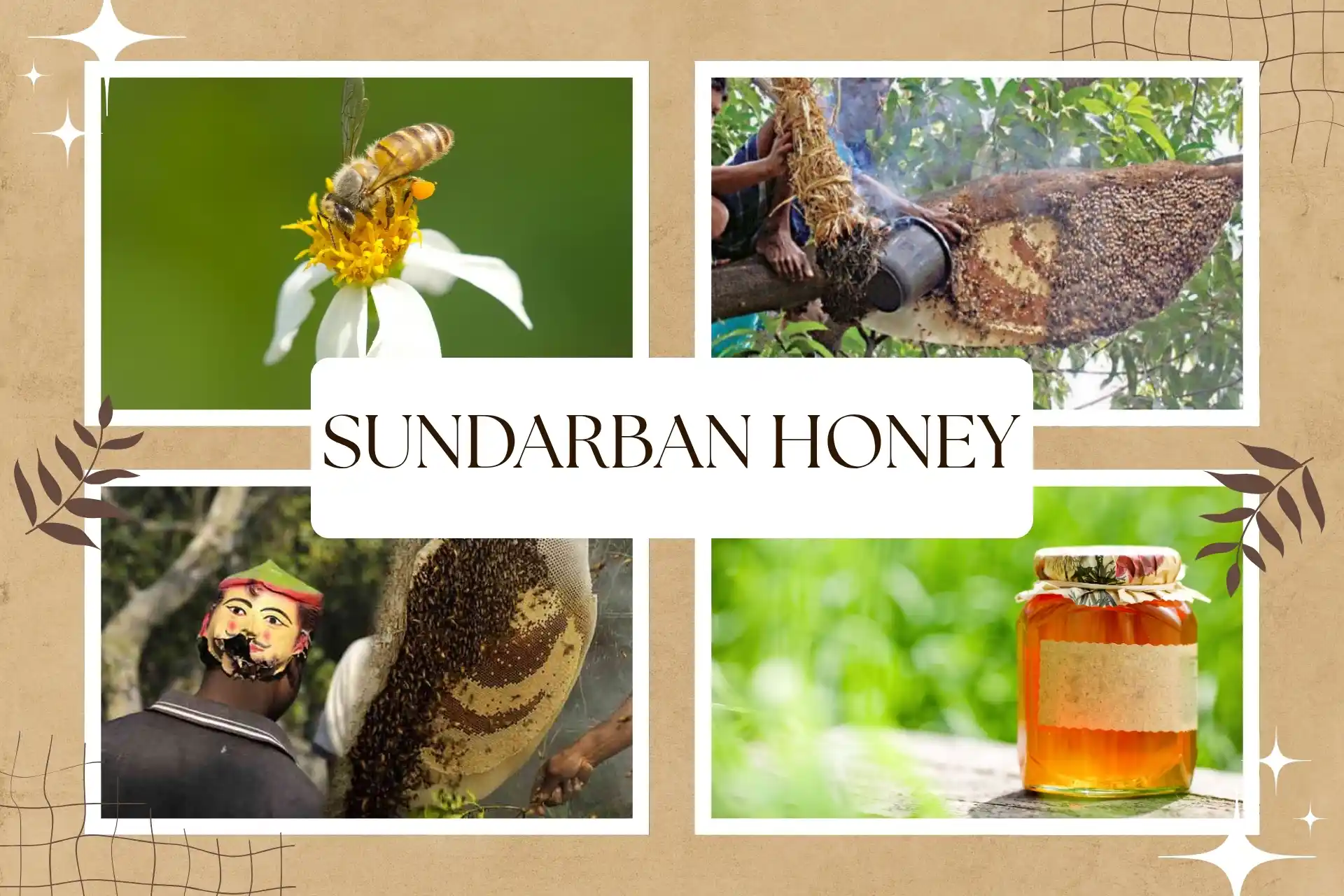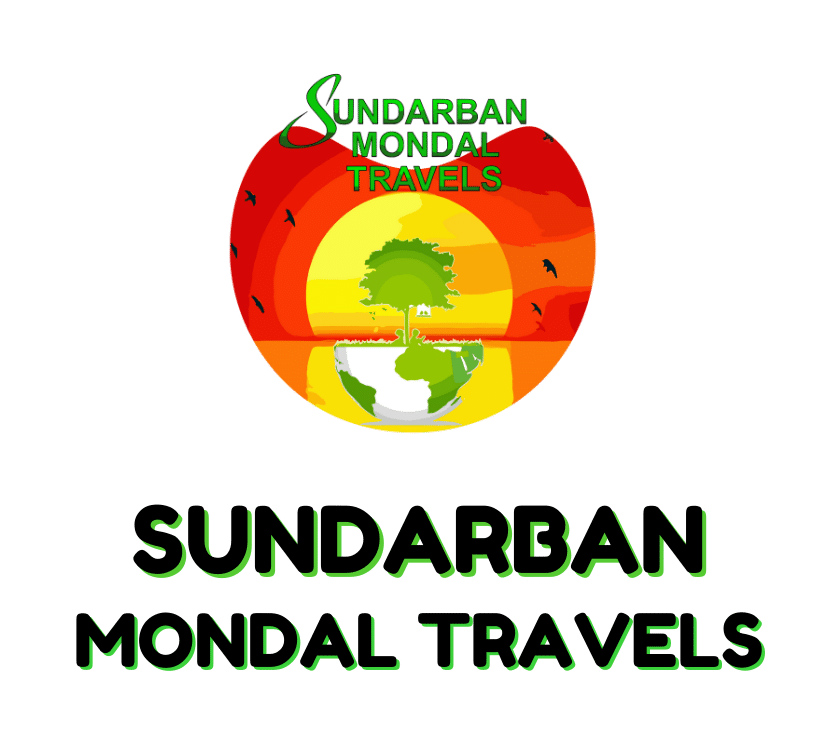Sundarban Honey: The Golden Treasure of the Mangrove Forest
A Journey That Begins with Courage
At Morning, when the forest is still wrapped in fog, a small wooden boat leaves the edge of the village. A group of Moulay honey collectors, carrying nothing more than ropes, knives, and smoke torches, sail silently into the Sundarban Mangrove Forest. They know the dangers well — tigers may be waiting nearby. But this is their life, their tradition.
For generations, Sundarban honey has been collected this way. It isn’t simply honey — it’s the result of bravery, heritage, and a fragile relationship between people and nature.

What Makes Sundarban Honey So Special
Sundarban honey collection comes from the world’s largest mangrove forest — a unique ecosystem where saltwater and freshwater meet. The wild honeybees (Apis dorsata) gather nectar from flowering mangrove trees like Gewa, Khalisha, Bain, and Keora.
This creates a distinct honey unlike anything produced in farms. It has a deep golden to reddish-brown color, a thick texture, and a smoky, earthy taste with a hint of natural salt. Since it is collected from untouched mangrove forests, pure Sundarban honey is naturally chemical-free.
Inside the Dangerous Honey Collection Process
Between March and June, when the flowers are in full bloom, licensed collectors enter the forest. Before setting out, they pray to Bonbibi — the forest goddess — for protection.
The collectors climb tall trees to reach hives while using smoke to calm the bees. It’s dangerous work. Many risk their lives every season, and not all return.
In Pakhiralay Market, we met the wife of a honey collector who was taken by a tiger during one of these trips. She now sells fuchka to support her family. This story is not rare — it’s the human cost behind this golden nectar.
Sundarban Honey Price (2025)
Despite its high risk of collection, the price of Sundarban forest honey remains accessible to most buyers. It is sold both in local markets and through branded outlets.
|
Bottle Size |
Price Range (INR) |
Notes |
|---|---|---|
|
100 ml |
₹129 – ₹150 |
Common retail packaging |
|
250 ml |
₹199 – ₹295 |
Regular local brands |
|
500 ml |
₹499 – ₹750 |
Premium Sundarban honey |
|
Premium Brands |
₹999+ |
Branded, export quality |
Collectors often receive ₹120–₹150 per kg, while retailers mark it up depending on packaging and distribution. Local shops in tourist zones like Pakhiralay often sell it directly to travelers.
A Taste Shaped by Nature
The flavor of pure Sundarban honey reflects the mangrove ecosystem itself — a little wild, a little unpredictable, yet rich and beautiful.
-
Color: Golden to reddish brown
-
Taste: Smoky, earthy, slightly salty
-
Texture: Thick, rich, and slow to crystallize
When buying honey, look for natural sediments like wax or pollen. That’s a sign it hasn’t been overly filtered or tampered with.
The Health Benefits of Sundarban Honey
For local communities, honey is not just a product — it’s medicine too. Over the years, scientific research has confirmed many traditional health benefits:
-
Supports natural immunity with strong antioxidant properties.
-
Acts as a natural prebiotic, aiding digestion.
-
Helps heal minor wounds and skin issues due to antibacterial effects.
-
Provides steady, natural energy as a sugar substitute.
-
Soothes sore throats and coughs.
Its mineral content, drawn from the mangrove soil and flowers, gives it a nutritional edge over regular farmed honey.
How to Identify Real Sundarban Honey
Because Sundarban honey has grown in popularity, imitation products have appeared in the market. A few simple checks can help avoid being misled:
-
Genuine honey has a rich texture, not watery.
-
The taste is slightly salty with natural earthy notes.
-
Authentic honey often contains pollen grains or wax particles.
-
Trusted brands carry certifications or GI tags.
-
Be cautious of overly cheap or crystal-clear honey.
In local tourist markets such as Pakhiralay and Sajnekhali, you’ll find both genuine and fake products. It’s best to buy from trusted sellers or certified online platforms like sundarbansjfmc.org.
Honey and the Heart of the Community
For Moulay families, honey is their main livelihood. It pays for their children’s education, their daily needs, and sustains cultural traditions. Selling honey in village markets is often the only way for these families to survive.
When travelers buy authentic Sundarban honey, they help sustain these communities. It’s not just a purchase — it’s a contribution to a living heritage.
Modern safety guidelines from the forest department aim to protect honey collectors while preserving the mangrove ecosystem.
Where to Buy Sundarban Honey
-
Local markets near Pakhiralay and Sajnekhali
-
Forest department-recognized eco shops
-
Certified online platforms such as sundarbansjfmc.org
Buying from authentic sources ensures that the honey is pure — and that your purchase supports those who risk their lives to collect it.
The Honey Trail: A Traveler’s Perspective
Every jar of Sundarban honey carries the scent of mangrove flowers and the stories of people who collect it. For travelers exploring this region, understanding its significance adds depth to the journey.
Seeing a Moulay boat return at sunset, covered in mud and stories, is an unforgettable moment. This is more than food; it’s history, ecology, and human resilience woven together.
Experience the Land of Sundarban Honey
If you want to experience the land where this honey comes from, Sundarban Mondal Travels offers immersive and safe tours through the mangrove forest.
With 10+ years of local expertise, our Sundarban Tour Package give you a real connection to the Sundarbans — its wildlife, rivers, people, and traditions. Explore responsibly, support local communities, and carry home a story worth remembering.
Final Words: A Treasure Worth Protecting
Sundarban honey is more than a sweet delicacy. It’s born from courage, nurtured by one of the world’s most delicate ecosystems, and carried to you by hands that risk everything.
When you taste pure Sundarban honey, you taste the forest — wild, rich, and alive. Supporting authentic sources means helping people preserve their culture and their land. And if you ever visit, you won’t just buy honey — you’ll witness the story behind it.
Book Now

which sundarban tour is best
which sundarban tour is best Introduction & Purpose of This Guide Planning a trip to Sundarban but confused about which tour package to choose — 1 Day, 2 Days, or 3 Days? You’re not alone. Many travelers struggle to pick the best option based on their time, budget, and expectations.

Sundarban Trees and Mangrove Forest
Sundarban Trees and Mangrove Forest 🌳 Overview of Sundarban Trees The Sundarban trees form the world’s largest mangrove forest, home to over 80 plant species. From the iconic Sundari tree to Goran, Golpata, Hetal, and more, each tree tells a story of survival, beauty, and cultural importance, protecting millions while

